Cast iron is the ultimate cooking material. It won’t break, is naturally nonstick, and holds heat like nothing else. But cast iron cookware also requires particular care to keep it in pristine condition.
This last fact keeps most people from using and enjoying their cast iron skillets and pans.
If you’re uncertain about cast iron skillet care and not using your pans as much as you should because of it, we’re here to help. In this ultimate care guide, you’ll learn how to season your cast iron, how to clean it, what to do if it rusts, and so much more.
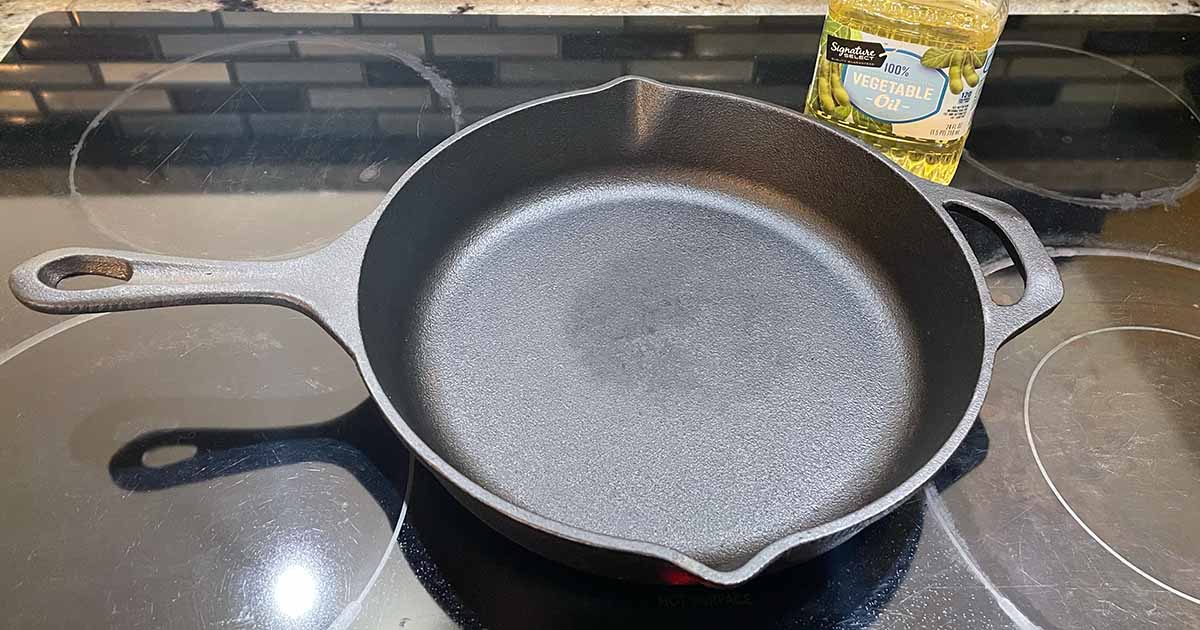
How To Care For Your Cast Iron Skillet
Did you just purchase your first cast iron skillet? Maybe you’ve had your grandma’s pan in the cupboard for years and are too afraid to use it for fear of ruining it.
Or, maybe you’ve been considering cast iron for a while but have yet to find a suitable skillet for your needs. If that’s the case, check out our Uno Casa Cookware review for a great, inexpensive cast iron option.
Whether you have a new, old, or yet-to-be-purchased cast iron skillet, you’ll want to keep reading.
Below, we’ve included everything you need to care for your cast iron to keep it looking and performing its best no matter how often you use it.
The First Wash
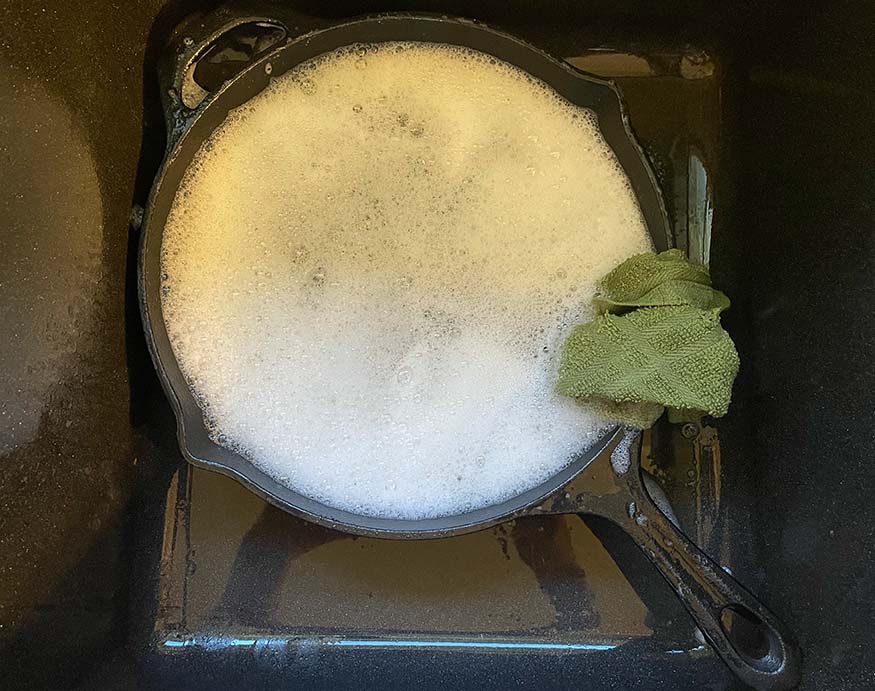
If you just bought a brand new cast iron skillet, it’s always a good idea to give it a good wash before using it. If the pan came from a relative, then washing it is optional and usually depends on how dusty or dirty it arrives.
In either case, the first wash for your cast iron skillet will look the same and shouldn’t take much time at all.
To clean your cast iron skillet for the first time:
- Fill the skillet with hot soapy water.
- Use a clean rag to wipe the outer surfaces with soapy water.
- Rinse well with cool water.
- Dry the entire pan and handle it very well with a clean, dry rag.
- Set the skillet on the stove and warm it on low until the whole pan is completely dry.
Now, some old-school cast iron collectors will tell you that you should never use soap on cast iron. This is true if you are using real soap, i.e., the kind that contains lye.
Luckily, most of us live in the modern world and only have mild dish detergent in the house. This kind of soap is entirely harmless to cast iron and can be used without fear, despite what your grandma says.
The much more real risk to your cast iron is moisture.
Warning: Moisture causes cast iron to rust, and it can happen very quickly. This is why drying your cast iron is the most critical step to washing it.
The easiest way to ensure your cast iron doesn’t have a chance to rust is to use the drying method outlined above. Start by hand drying it until all visible water is gone, then warm it on the stove so the heat can evaporate any remaining water molecules.
Once completely dry, you can store your cast iron in the cupboard, on the wall, on the counter, or anywhere else it will stay dry. Just, whatever you do, make sure it is completely moisture-free before you put it away.
Seasoning Your Cast Iron Cookware
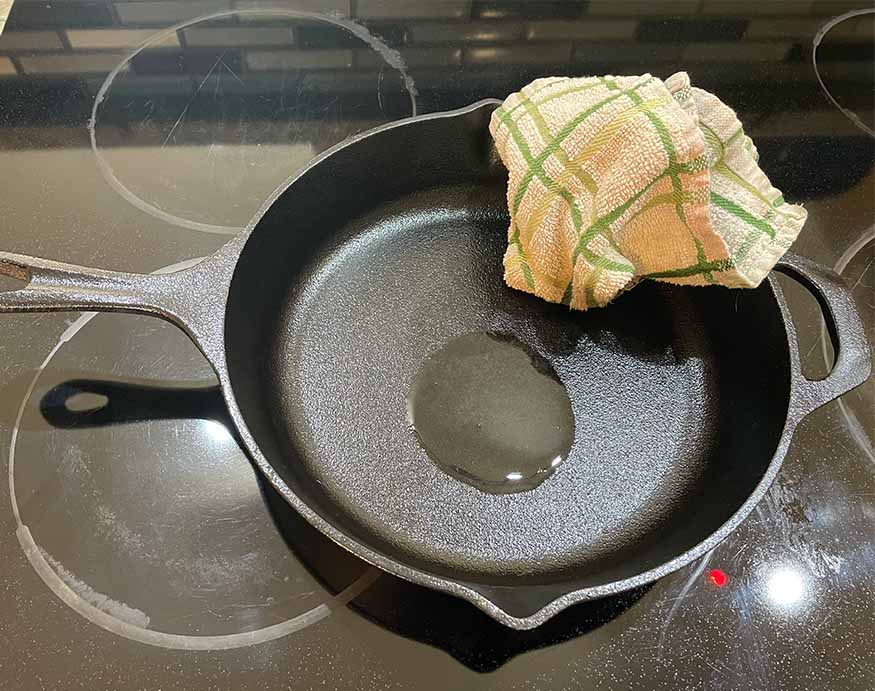
Another critical step to keeping your cast iron rust-free is to season it with oil. This process creates a moisture barrier, preventing rust. It also creates a natural, non-stick cooking surface.
All raw cast iron cookware needs to be seasoned, but when you need to do it and how often varies depending on many factors.
What Is Cast Iron Seasoning?
Seasoning a cast iron pan is simply the act of heating oil on the surface to create a polymerized bond between the two materials. This tough bond helps protect the iron from moisture and damage caused by cooking utensils. It also helps keep food from sticking.
Note: You can use any kind of oil to season a cast-iron skillet, but some make a better choice than others.
Vegetable oils, such as canola or vegetable shortening, are optimal for seasoning cast iron because of their high smoke point and resistance to spoilage.
More fragile oils, such as olive, can go rancid when exposed to oxygen for long periods. This is only problematic if you use too much oil during the seasoning process or do not heat the pan enough to polymerize the oil thoroughly.
Do I Need to Season My New Cast Iron Skillet?
These days, most new cast iron skillets come pre-seasoned, meaning the manufacturer applied oil to the pan and heated it before shipping.
In some cases, this preseasoning is enough to protect your pan through many uses. But, often, it offers only a thin layer of protection that is easily worn down. It is best to season your new pan regardless of if it has been pre-seasoned or not.
How to Season a Cast Iron Skillet
There are many ways to season a cast-iron skillet, but the basic idea is the same: heat a thin layer of oil to bond it with the cast iron.
For new skillets and occasional maintenance, you will want to do a full seasoning, which means seasoning the outside of the pan and the cooking surface. This must be done in the oven.
To season your entire cast iron pan:
- Place your clean skillet in the oven at 200 degrees for 20 minutes.
- Using hot pads, remove the skillet from the oven.
- Using a clean cloth that can be discarded, coat the entire skillet using vegetable shortening or canola oil.
- Once thoroughly coated, use another clean rag that can be discarded to wipe out as much of the oil as you can.
- Return the pan to the oven, put it upside down, and crank up the heat to 300.
- Once the oven reaches 300, remove the pan and wipe out any remaining oil.
- Place the skillet back in the oven and heat it at 450 degrees for 1 hour.
- After 1 hour, turn the heat off and allow the pan to cool in the oven.
Repeating this process three times is ideal, especially if your pan did not come pre-seasoned.
Note: The outer surfaces of your pan only need to be seasoned once or twice a year, or less if you are careful about how you wash and dry your skillet. But the inside surface will likely need to be seasoned more frequently.
Luckily, you don’t have to go through the full process outlined above each time the inside of your skillet needs to be seasoned. Instead, you can do a short season of the cooking surface on the stovetop.
To season the cooking surface of your cast iron skillet on the stovetop:
- Heat your pan on medium heat on the stovetop.
- Rub the inner surface with vegetable oil using a paper towel or rag.
- Wipe as much oil as possible using a clean rag.
- Heat the pan on medium until the remaining oil begins to smoke.
- Remove the pan from the heat and allow it to cool.
Some people complete this process after every use. Others only do it if they notice food beginning to stick to the pan or if they see rust or scratches on the pan’s surface.
If you notice the latter, be sure to repeat the stovetop seasoning process three times before putting the pan away.
What Cooking Utensils Should You Use?
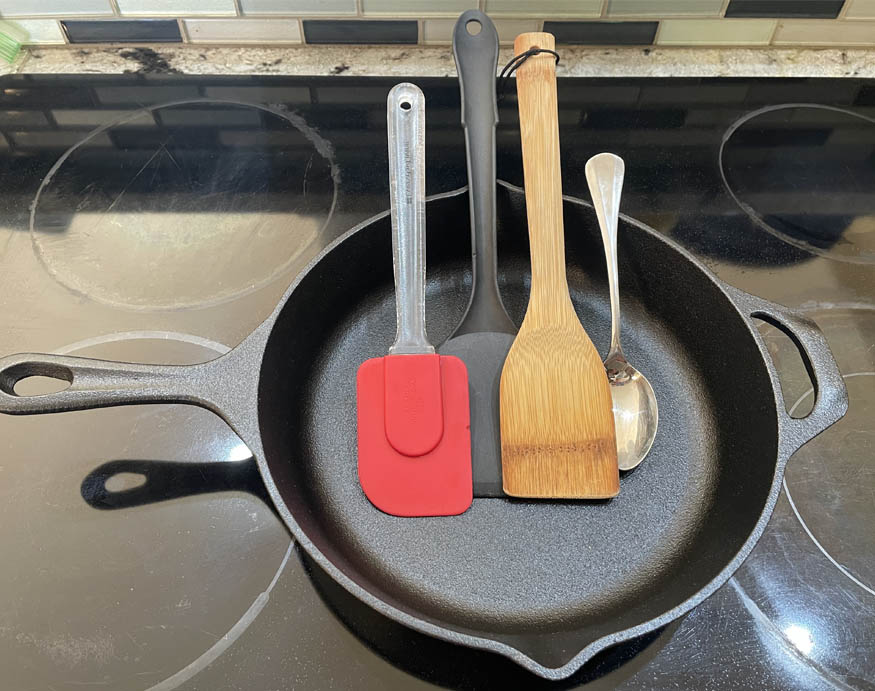
There are a lot of rules when it comes to caring for cast iron. Some people confuse this finickiness with weakness. But the truth is, cast iron is among the best types of cookware you can cook with.
Cast iron itself is incredibly difficult to scratch. Moreover, the slick surface created by seasoning is also very resistant to damage, especially if you have taken the time to build up the seasoning layers.
Note: You can use any type of utensil you want on your cast iron skillet.
Wood, silicone, plastic, and metal utensils are all safe to use. While you want to be careful with metal utensils with sharp edges, rounded metal is unlikely to damage your seasoning layer and will not scratch your cast iron.
How To Clean Your Cast Iron Skillet After Cooking
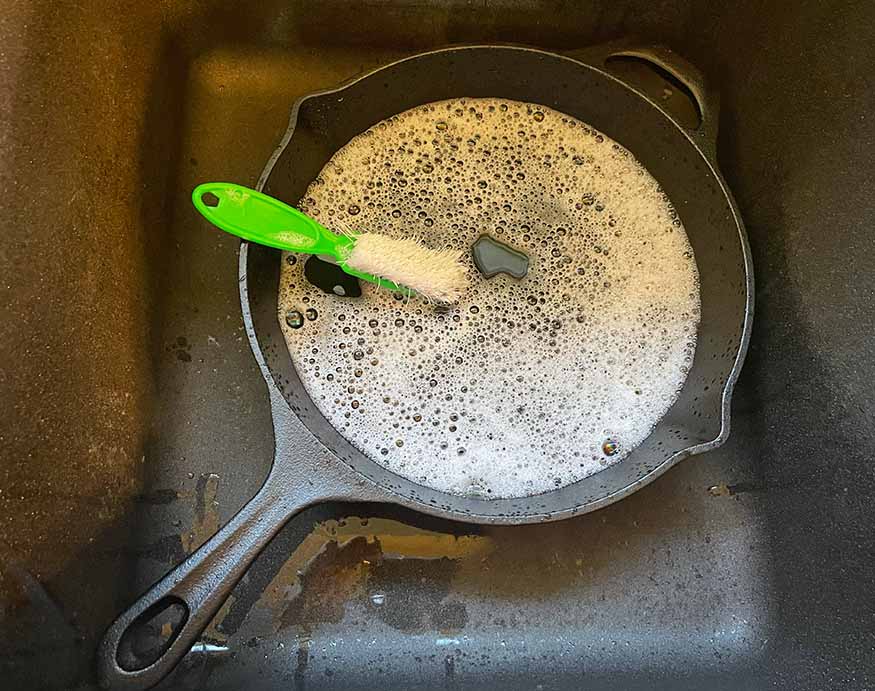
Because cast iron is so prone to rust, many novice chefs get confused about the best way to clean a dirty cast iron pan. The fact that there is a valuable layer of cooked-on oil on the pan’s surface only further complicates the prospect of getting the thing clean.
The truth is, cleaning your cast iron pan is pretty straightforward. And, once you know the steps, it is almost as easy as caring for any other pan in your kitchen.
To clean your cast iron skillet after cooking:
- Allow the cast iron to cool some. It should be cool enough to handle but still warm to the touch.
- Scrape off any visible food residue with a plastic scraper.
- Fill the skillet with warm water.
- Scrub the surface with a chainmail scrubber or coarse bristled brush.
- Rinse the pan.
- Dry thoroughly with a clean, lint-free cloth.
- Apply a small amount of vegetable oil to the cooking surface.
- Wipe away all excess oil.
- Place the pan on the stove on medium heat until the oil begins to smoke.
Many people stop at step 6 when cleaning their cast iron. As long as the pan is completely dry, there is no harm in putting it away without oiling it. However, if you choose to go this route, you’ll need to go through the full seasoning process more frequently.
Some people stop at step 8. Applying oil to the pan after each use helps protect it from moisture and maintains the integrity of the seasoning layer, regardless of if you heat it after or not.
However, heating the pan after oiling it polymerizes the added oil, preventing it from going rancid.
If you don’t heat the oil after applying it and the pan sits for a few weeks without being used, the oil can go rancid and cause problems the next time you cook.
If you use your pan multiple times per week, then this is unlikely to be an issue. If you use it less frequently, be sure to oil your pan only with stable vegetable oils such as Crisco or canola, as these are less likely to go rancid.
How to Remove Stubborn Stuck on Food
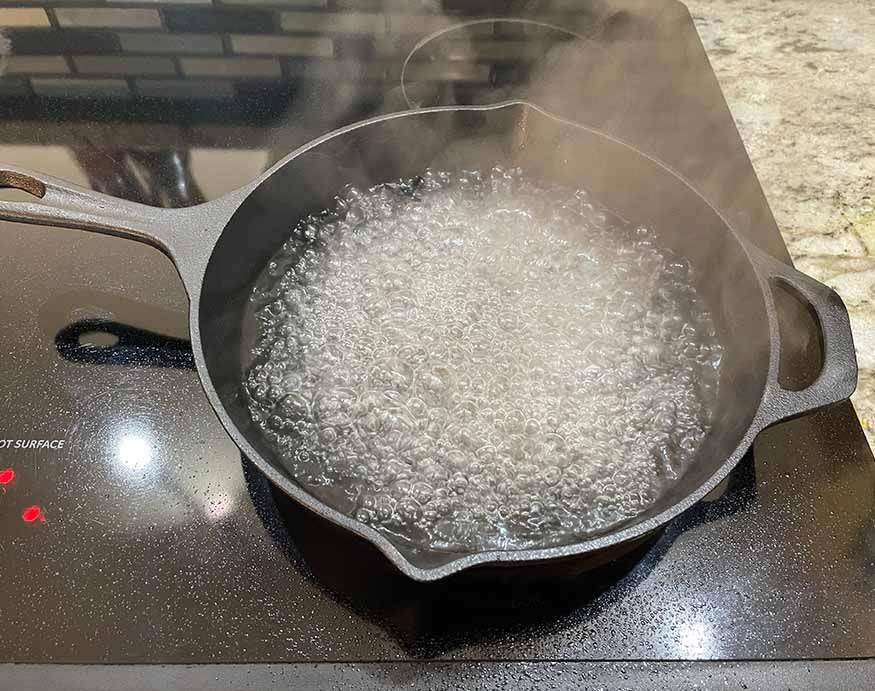
If you have an excellent seasoning layer, then it is unlikely food will become too stuck on to remove with soap and water. But if the pan burns or the seasoning layer has broken down, then you may end up with a mess that can’t be easily scraped and scrubbed away.
In this case, you’ll want to boil water in the pan to help unstick the food residue before attempting to clean the pan.
- Fll the skillet with water and boil it on the stovetop for about 5 minutes.
- Once the pan has cooled, use a scraper and soap, and water to clean the softened food off the surface.
- If this still isn’t enough, try making a scrub out of salt and oil.
- Use a sponge to scrub this mixture over the surface to help remove stubborn burnt-on food.
Once the pan is clean, be sure to reseason it to re-establish a strong, non-stick surface.
Should You Soak Your Cast Iron Pan?
One thing you never want to do to get stuck-on food off your cast iron skillet is to soak it.
Anytime your cast iron is exposed to moisture, you run some risk of it rusting. The longer the exposure, the more likely it is that rust will form. For this reason, you never want to leave your pan sitting with water in it or around it for extended periods.
Can You Put Your Cast Iron in the Dishwasher?
Washing your cast iron pan in the dishwasher is another big no-no.
Dishes in the dishwasher are exposed to water repeatedly throughout the washing process and are left damp for an extended period afterward, even with the heated-dry mode activated. All this excess moisture is likely to make even a well-seasoned cast-iron skillet rust.
What If Your Skillet Has Rust?
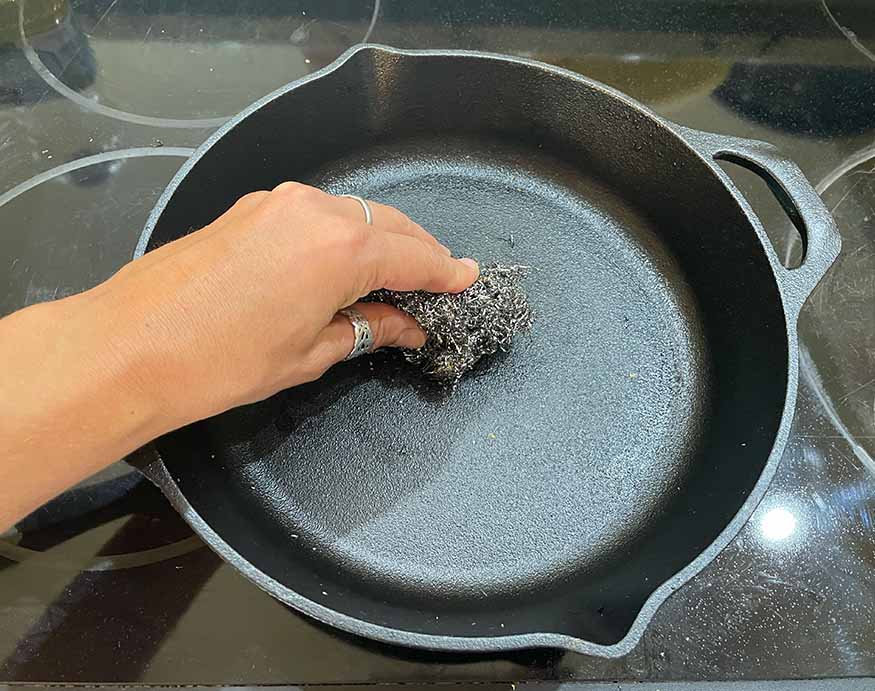
If your cast iron skillet does end up getting a little rust, or if you inherit a very rusty pan, there’s no need to worry. Rust is a common problem with cast iron and is easily removed—even if there’s a lot of it!
To remove rust from your cast iron:
- Use steel wool or a cast iron rust eraser tool to scour the rusty area and remove all visible signs of rust.
- Wash the pan thoroughly with warm, soapy water.
- Dry the surface completely with a clean towel. If needed, you can warm the pan on low on the stovetop to ensure it is dry.
- Go through the steps outlined above to season the pan in the oven thoroughly.
Cast Iron Skillet FAQ
Is cast iron cookware safe?
Generally speaking, yes, cast iron cookware is very safe to cook with. Unlike many other modern cooking materials, this age-old metal is made of only a few things: iron, carbon, and trace minerals. That means there are very few things to consider when looking at the potential health effects of this material.
The only real concern with cast iron is that the iron can leach into food during cooking. This isn’t a huge issue, as iron is a necessary nutrient for all people. However, people with a genetic condition called hemochromatosis and those who eat a lot of red meat could get more iron than is healthy by cooking in cast iron frequently.
Keeping a good seasoning on your cast iron helps prevent iron absorption into your food.
Is cast iron safer than Teflon?
At low heat, both cast iron and Teflon pans are generally considered safe to use. However, Teflon is known to break down at high heat. When this happens, it releases a toxic gas called perfluorooctanoic acid (PFOA) that can cause reproductive problems, immune system issues, and cause tumor growth.
Teflon releases PFOA when it reaches temperatures above 500 degrees. Unfortunately, because Teflon pans often utilize thin, highly conductive metals, it doesn’t take much heat to bring the temps of these pans to the burning point. When left on medium heat on the stovetop, an empty Teflon pan can reach that temperature threshold in a matter of minutes.
Because cast iron is highly stable at extreme temperatures, it is a much safer choice for cooking food on medium and high heat.
Can you cook eggs in cast iron?
Yes, you can cook eggs on cast iron. In fact, this is one of the preferred materials for cooking eggs because the natural nonstick surface keeps the eggs from sticking no matter how you prepare them.
Can you cook garlic in cast iron?
Some people warn against cooking stinky foods such as garlic in your cast iron pans. This is because some of the oil used during cooking will become part of the seasoning layer of the cooking surface. The food odors in the oil will also be captured and may add some flavor back into the next dish you cook.
This isn’t likely to be a problem if you only cook savory foods in your cast iron. But if you cook garlic curry one day and pancakes the next, you will quickly see why cooking stinky food in cast iron can cause issues.
Luckily, it is easy to get rid of cooked-in odors on cast iron. Simply place the cleaned skillet in the oven at 400 degrees for 15 minutes. This will eliminate the lingering smells and flavors without compromising your seasoning layer.
Cast Iron Cookware – Forever!
Cast iron is a bit of a finicky material to use, but once you know how to care for it properly, you’ll quickly realize why so many professional chefs love these pans.
By seasoning your skillet correctly, washing it with the right tools, and drying it thoroughly, you can keep your cast iron looking and performing like new for decades to come.